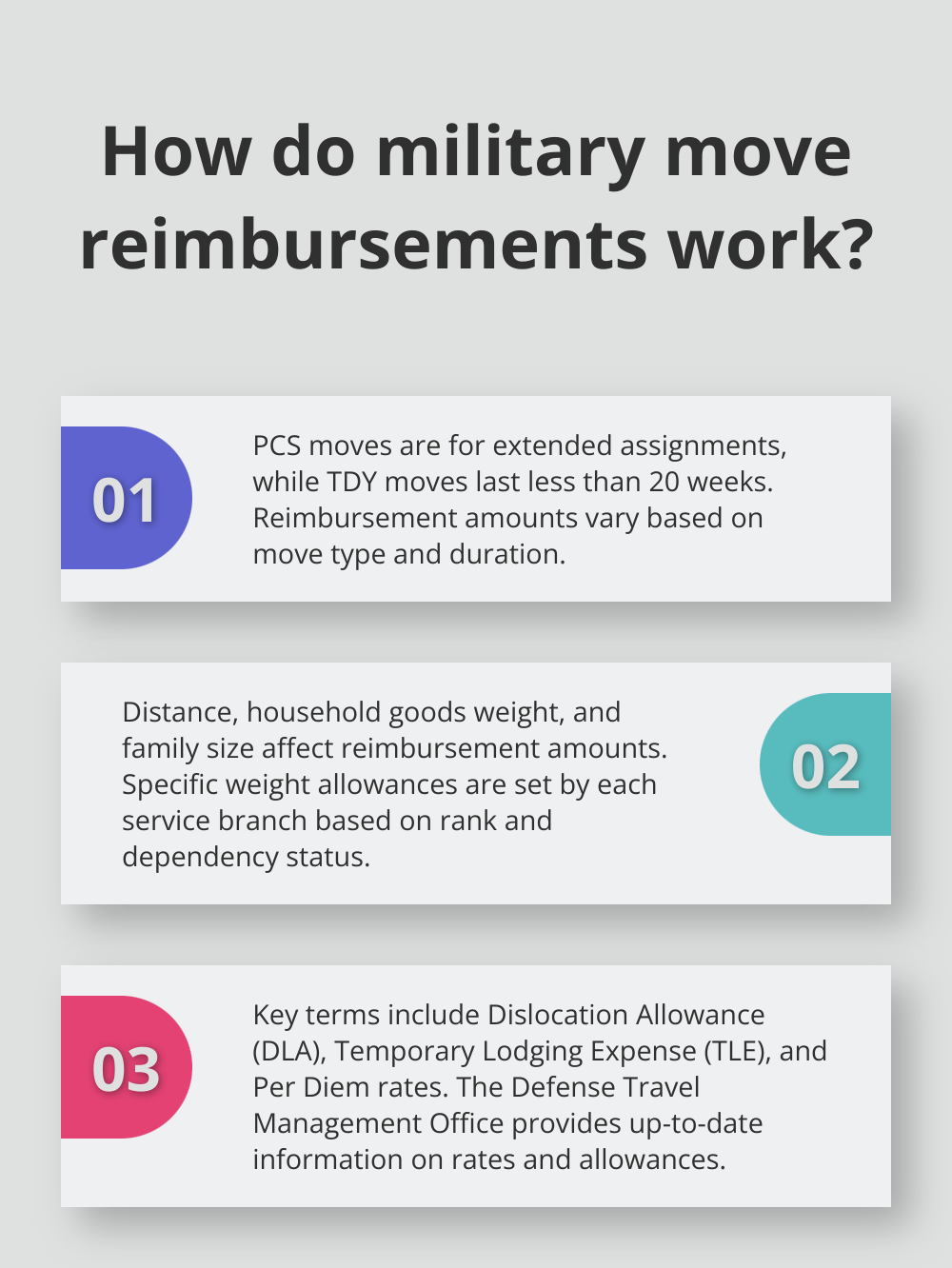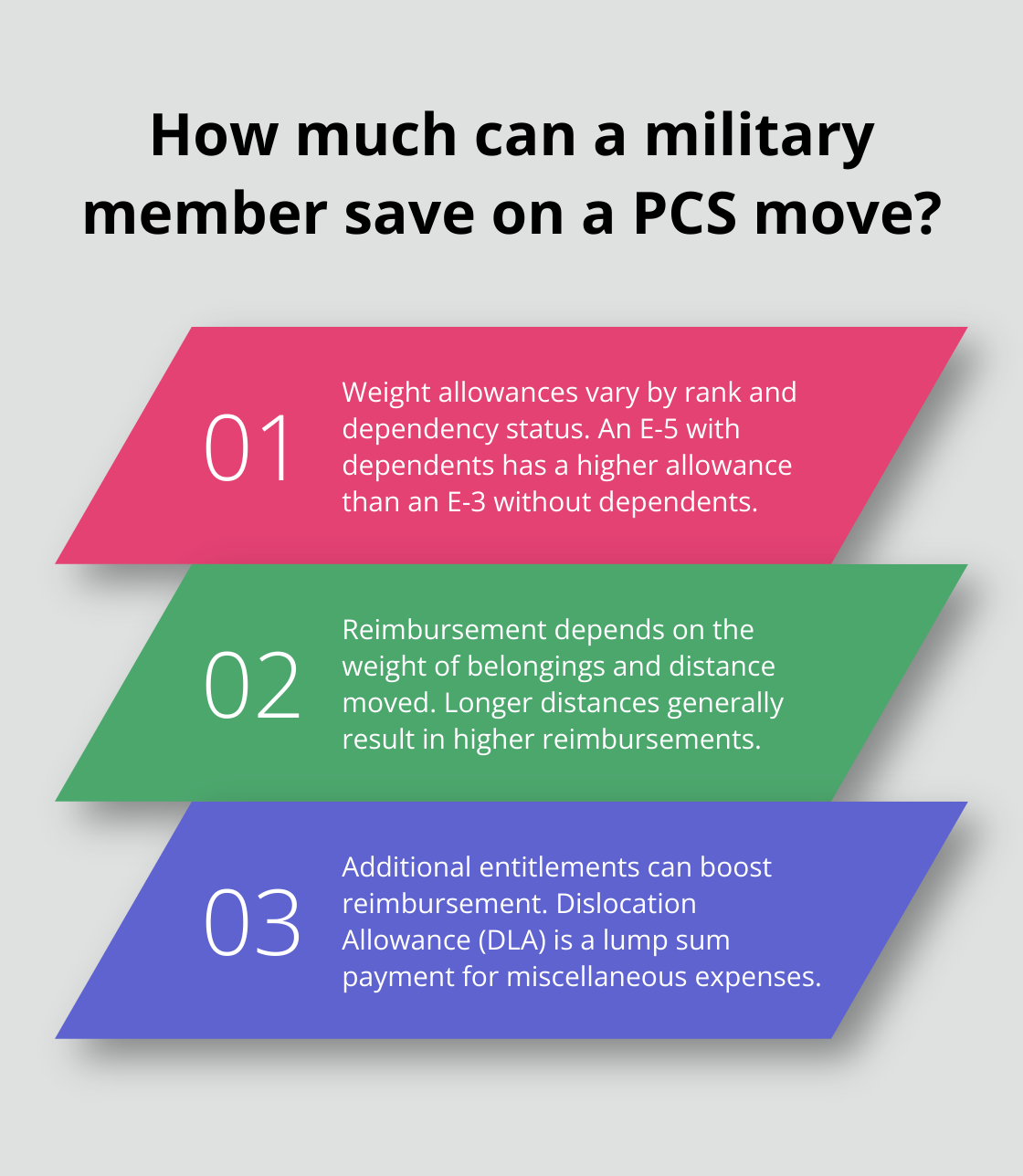Military moves can be complex, especially when it comes to understanding reimbursements. At Southbay Moving Systems, we’ve helped countless service members navigate this process.
This guide will walk you through using a military move reimbursement calculator and provide tips to maximize your benefits. We’ll cover everything from gathering necessary documents to estimating weights accurately.
What Are Military Move Reimbursements?
Types of Military Moves
The Department of Defense (DoD) recognizes several types of military moves, each with its own reimbursement structure. Permanent Change of Station (PCS) moves occur when a service member receives an assignment to a new duty station for an extended period. Temporary Duty (TDY) moves involve shorter-term assignments, typically lasting less than 20 weeks.
Factors Influencing Reimbursement Amounts
Several factors affect reimbursement amounts. The distance of the move plays a significant role, with longer distances generally resulting in higher reimbursements. The weight of household goods is another critical factor, with each service branch setting specific weight allowances based on rank and dependency status.

Family size impacts reimbursements as well. Service members with dependents often receive higher allowances for housing and other expenses compared to single service members. Additionally, the location of the new duty station can affect reimbursement rates, particularly for overseas assignments or high-cost areas within the United States.
Key Terms for Military Move Reimbursements
To navigate the reimbursement process effectively, service members should familiarize themselves with key terms:
- Dislocation Allowance (DLA): A payment to partially reimburse a servicemember, with or without dependents, for the expenses incurred in relocating.
- Temporary Lodging Expense (TLE): Provides reimbursement for short-term housing costs during the transition.
- Per Diem rates: Daily allowances for meals and incidental expenses during travel.
- Monetary Allowance in Lieu of Transportation (MALT): Compensates service members who choose to drive to their new duty station instead of using government-provided transportation.
Understanding these terms and how they apply to your specific situation is important for maximizing your reimbursement. The Defense Travel Management Office provides up-to-date information on rates and allowances.
Importance of Accurate Documentation
Proper documentation forms the foundation of a successful reimbursement claim. Service members should keep detailed records of all expenses related to their move, including:
- Receipts for lodging, meals, and transportation
- Weight tickets for household goods
- Rental agreements or mortgage documents
- Vehicle registration and insurance information
These documents will support your claim and help ensure you receive the full reimbursement you’re entitled to.
Navigating the Reimbursement Process
The military move reimbursement process can seem complex, but breaking it down into manageable steps can make it less daunting. The next chapter will guide you through the calculation of your specific reimbursement and provide strategies to maximize your benefits.
How to Calculate Your Military Move Reimbursement
Gather Essential Documentation
The first step to calculate your reimbursement requires collection of all necessary paperwork. This includes your official orders, which outline the specifics of your move. You’ll need weight tickets for your household goods (both empty and full). Keep all receipts related to your move, including those for temporary lodging, fuel, and any incidental expenses. Document mileage if you’re driving to your new duty station.
Use Official DoD Calculators
The Department of Defense provides several online calculators to help you estimate your reimbursement. The Defense Travel Management Office website hosts these tools. The Permanent Change of Station (PCS) calculator proves particularly useful for most moves. This comprehensive DITY move calculator for PCS moves allows you to view eligible allowances and estimate expenses and profit. Input your rank, dependency status, and move details to get an estimate of your entitlements. These calculators provide estimates, not guaranteed amounts.
Factor in Weight Allowances and Distance
Your reimbursement depends heavily on the weight of your belongings and the distance of your move. Each service branch sets specific weight allowances based on rank and dependency status. For example, an E-5 with dependents typically has a higher weight allowance than an E-3 without dependents. Distance calculations use official military tables, not necessarily the actual miles driven. Longer distances generally result in higher reimbursements.
Account for Additional Entitlements
Don’t overlook additional entitlements that can increase your reimbursement. The Dislocation Allowance (DLA) is a lump sum payment to help cover miscellaneous moving expenses. Temporary Lodging Expense (TLE) reimbursement is limited to 21 days for a CONUS to CONUS PCS and 7 days for an Out of the Continental United States move. If you’re moving overseas, you might qualify for an Overseas Housing Allowance (OHA) or Cost of Living Allowance (COLA). These additional entitlements can significantly boost your overall reimbursement.
Seek Professional Assistance
Many service members underestimate their reimbursements by overlooking important details. Professional moving companies (like Southbay Moving Systems) often have experience with military moves and can provide valuable insights. They can help you understand the nuances of the reimbursement process and ensure you don’t miss out on any benefits. The time you invest in this process can result in substantial financial benefits as you transition to your new duty station.

The next chapter will explore strategies to maximize your reimbursement and minimize out-of-pocket expenses during your military move.
How to Maximize Your Military Move Reimbursement
Estimate Weight Accurately
The weight of your household goods plays a significant role in determining your reimbursement. To get an accurate estimate:
- Create a detailed inventory of your belongings.
- Use online weight calculators designed for military moves.
- Consider a professional pre-move survey (many moving companies offer this service at no cost).
Reduce Out-of-Pocket Expenses
The military covers many moving costs, but some expenses can slip through the cracks. To keep these to a minimum:
- Plan your route carefully to avoid unnecessary mileage and lodging costs.
- Take advantage of military lodging facilities when available (they’re often cheaper than commercial hotels).
- Use a government travel card for eligible expenses to avoid using personal funds.

Try to save and/or invest 10% – 15% of pretax pay. Strive to keep transportation expenses including car payments, insurance, gas and maintenance to 15% – 20% of your budget.
Document All Costs
Keep meticulous records of all expenses related to your move. This includes:
- Receipts for packing materials (if you’re doing a Personally Procured Move).
- Tolls and parking fees during travel.
- Temporary lodging expenses.
- Costs associated with setting up utilities at your new home.
Use All Available Benefits
The military offers various benefits beyond basic moving allowances. Make sure you’re aware of and utilize all available options:
- Dislocation Allowance (DLA): This can cover miscellaneous moving expenses.
- Temporary Lodging Expense (TLE): Helps with short-term housing costs during your transition.
- Per Diem rates: Daily allowances for meals and incidental expenses during travel.
Seek Professional Assistance
Professional moving companies (like Southbay Moving Systems) often have extensive experience with military moves. They can provide valuable insights into the reimbursement process and ensure you don’t miss out on any benefits. The time you invest in this process can result in substantial financial benefits as you transition to your new duty station.
Final Thoughts
Military move reimbursements require careful planning and accurate documentation. Service members should use official DoD calculators, including the military move reimbursement calculator, to estimate their entitlements and plan their finances. Meticulous record-keeping, precise weight estimation, and the use of all available benefits will maximize reimbursements.

Proper planning contributes to a smoother move and potentially higher reimbursement. Documentation forms the foundation of successful claims, from weight tickets to lodging receipts. Service members who maintain comprehensive records position themselves for optimal reimbursement outcomes.
Southbay Moving Systems offers specialized services tailored to the unique needs of service members. We provide personalized packing, secure storage solutions, and transparent pricing (based on our experience with military relocations). Our expertise in navigating the intricacies of military moves can prove invaluable in ensuring a stress-free relocation experience while maximizing reimbursement potential.




